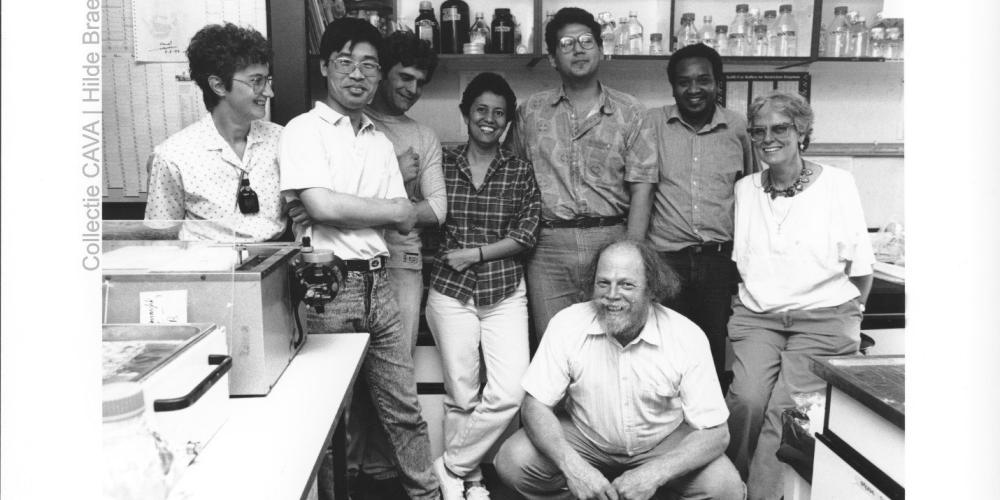
The discovery of nanobodies by Cécile Casterman and her husband, Raymond Hamers - and later Serge Muyldermans and Jan Steyaert – in the 1980s fundamentally changed approaches in different areas of medicine. It provided a boost and a major leap forward in the diagnosis and treatment of serious and life-threatening diseases.
Tekst: Ilja Van Braeckel and Sarah Janssens
Photo: CAVA Collection - Hilde Braet
The discovery of nanobodies by Cécile Casterman and her husband, Raymond Hamers - and later Serge Muyldermans and Jan Steyaert – in the 1980s fundamentally changed approaches in different areas of medicine. It provided a boost and a major leap forward in the diagnosis and treatment of serious and life-threatening diseases.
Both being retired, they like to garden when the weather allows it. At first sight there's not much to indicate that Cécile Casterman and Raymond Hamers made a discovery that shook the global biotech sector. But they still sip their coffee out of VUB mugs.
Let’s go back to the year 1989, just before their revolutionary discovery.
Hamers: "We were teaching. Just before summer, we still had to teach VUB students how to subtract antibodies from blood, to be able to study them. My wife launched the ingenious idea to use dromedary blood. The students thought we had gone mad (laughs). But the result stunned us.
Raymond Hamers:
My wife launched the ingenious idea to use dromedary blood. The students thought we had gone mad.
Hamers: “Some antibodies consisted of only one single piece. Normally, antibodies are composed of two different pieces, or ‘chains’. When an intruder enters the body of an animal, these two pieces stick together into one antibody. So if a biotech company wanted to make a synthetic antibody, they had to paste the chains together: quite an elaborate task. But in dromedaries, one chain sufficed to have the same effect. The antibodies were smaller, which is why we called them ‘nanobodies’. By using those, the production of antibodies became much faster, and a hundred times cheaper. We bought a handful of dromedaries on a Moroccan cattle market and after ten years of research, we were certain: dromedary blood was like no other."
Continue reading below the picture.

How did you protect that discovery and how did other researchers react?
“We paid €25,000 of our own savings to patent it, before the university decided to take it over. The third inventor on the patent, Serge Muyldermans, was a colleague in the lab of the VUB. One year later (in 1993, ed) the first scientific article appeared in the journal Nature. At first, everybody was sceptical, as you would expect of good scientists. Little by little, people realised this was something special. It wasn’t long before big pharmaceutical companies reached out to us. But we decided to create our own spin-off company, with the help of VIB (Flemish Institute of Biotechnology) and several young researchers of the lab and we called it Ablynx.”
How did the business life treat you?
“We relied on people more suited to run the company. And we went back to doing what we loved most: research and teaching. Money was never a driver; we already had a comfortable life. In 2013, we launched a chair with a part of the proceeds. Several international speakers are invited to teach about the history and philosophy of science."
Big breakthrough thanks to VUB spin-offs
As a result of the discovery, several VUB spin-offs emerged and different kind of drugs are on the verge of being launched in the years to come. Also in agriculture, a big breakthrough is expected as nanobodies or ‘agrobodies’ can be used to protect food crops and contribute to more sustainable food production. Ablynx was the first VUB spin-off to start developing nanobody-based therapeutic programmes in various areas including inflammation, hematology, immuno-oncology and respiratory disease. By the end of 2018 the company launched its first drug, Caplacizumab. It treats thrombotic thrombocytopenic purpura (TTP), a rare blood disorder that causes blood clots in small veins throughout the body.
Two more VUB spin-offs are based on the discovery of nanobodies for developing treatments. Confo Therapeutics (VUB-VIB spin-off) runs drug discovery programmes influencing diseases such as neurological and psychiatric diseases (schizophrenia, depression, Alzheimer's disease and Parkinson's disease) and fibrosis (liver and lungs). Camel-IDS develops a treatment that attacks cancer cells from inside the body. This therapy is more efficient than the classical radiation, which also damages healthy body cells. Its lead programme focuses on the treatment of brain metastases in breast cancer, but the company also aims to tackle other types of cancer in the future like lung cancer, ovarian cancer and pancreatic cancer.
Gulliver Biomed, another VUB spin-off founded in 2018 together with the university of Ghent, aims to develop nanobodies for researchers in knowledge institutions and companies in their scientific search. AgroSavfe, on the other hand, is focusing on the development of effective and safe biocontrols to tackle pests and diseases in food crops. It wants to offer a reliable crop protection alternative for farmers to sustainably produce healthy, high-quality food.
--
You can find all articles of the festive magazine here.